Sisters-1973
Director Brian De Palma
Starring Margot Kidder, Jennifer Salt
Scott’s Review #178
Reviewed September 29, 2014
Grade: B+
Directed by stylistic film genius Brian De Palma, Sisters (1973) is an early entry in the famed director’s repertoire and a direct homage to the classic films of Alfred Hitchcock.
The film stars Margot Kidder as a French-Canadian model named Danielle Breton, who shares a Staten Island, NY apartment with her demented twin sister Dominique. For many years Danielle and Dominique were conjoined twins and only recently surgically separated.
After a romantic date with a new acquaintance, Danielle begins to feel ill and Dominique murders the new boyfriend after he surprises, who he thinks is Danielle, with a birthday cake.
But is it Dominique or is it Danielle?
Meanwhile, a neighbor, Grace Collier played by Jennifer Salt, witnesses the murder from across the alley, and in a highly dramatic scene, involving the victim attempting to scrawl “help” on the window, Grace gets the police involved.
The authorities are skeptical and unsympathetic to Grace’s claims since she works as a newspaper reporter and is constantly challenging the police department in her articles.
Finally, when the police do search Danielle’s apartment, no dead body is found. This sets off the plot for the remainder of the film as Grace looks for the missing body on her own (in Nancy Drew’s style) with the help of a detective she hires, Joseph Larch, comically played by Charles Durning.
One point to mention about Sisters is that the film is a blueprint for De Palma films to come, but that does not mean it is not engaging on its own merits- it pales in comparison to other De Palma gems that followed, such as Carrie and Dressed to Kill.
It feels raw and slightly underdeveloped compared to those aforementioned films.
Danielle’s ex-husband and doctor, Eli, while creepy and sinister, is not fully explored, and his relation to events taking place is a bit vague throughout much of the film.
Techniques such as the split-screen showing simultaneous action oftentimes relating to each other are introduced in this film and are a marvel to watch as so much of the plot is revealed in these sequences- activity in Grace’s apartment contrasts with and interchanges perfectly with action in Danielle’s apartment- highly effective and suspenseful.
DePalma uses many Hitchcock influences, but in no way steals them- the idea of a set of conjoined twins with mental illness was taken from a real-life story of Soviet twins.
Viewers familiar with Psycho will smile during the murder scene as influences are apparent- Rear Window is certainly referenced as countless scenes of the camera looking into Danielle’s or Grace’s apartment or the camera looking out onto a street scene or someone with binoculars spying out of their apartment and into someone else’s apartment across the street- very visually oriented.
The Hitchcock similarities continue with the musical score- it is composed by Bernard Hermann, a frequent collaborator of Hitchcock films- think Vertigo.
After all of the psychological build-up throughout the first hour of the film, the final thirty minutes or so, taking place within the confines of a mental asylum, is confusing and unrealistic, as various flashbacks and dream sequences are used, even using one character taking the place of another in a dream- edgy and unique, but tough to follow and organize properly.
Grace is assumed to be a newly admitted mental patient seemed far-fetched. What exactly transpired between Danielle and Dominique present and/or in the past?
Even though events are explained, I found myself scratching my head a bit after the film.
For fans of Brian De Palma films, Sisters (1973) is a perfect movie experience to show the influence to come and not a bad film on its own either.
